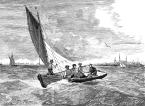One of the most disastrous expeditions in whaling history, the destruction of the Whaleship Essex, is now on the big screen in Ron Howard’s film In the Heart of the Sea.
Nathaniel Philbrick’s book In the Heart of the Sea: The Tragedy of the Whaleship Essex, on which the movie is based, tells a tale of horror. Of the 21 men aboard the Essex, only eight were rescued, and some of the sailors who died were eaten by the survivors.
Less known is that one-third of the Essex’s crew was black — part of a long tradition of black whalers sailing out of southern New England, including Martha’s Vineyard.
Whaling wasn’t about fishing; it was about oil, and southern New England was the Middle East of its day. From the mid-1700s until the early 1900s, whaling was the third largest business in Massachusetts and the fifth largest in America — and the second most dangerous after mining. There was no shortage of discrimination on land in the late 1800s, but whaling fleet owners were more motivated by cash. On a whaleship, the ability to kill whales and get the crew home was what really mattered.
Between 20 and 40 per cent of whalers were black, and the danger and difficulty of the business produced the opportunity for 64 of them to become captains, beginning even during the days of slavery and continuing to the end of the industry. This group included William A. Martin of Edgartown, who commanded at least nine voyages between 1870 and 1887. He died on Chappaquiddick in 1907. These black captains’ skills allowed them to return with whale oil valued at over $100 million in today’s dollars.
One of them, Collins A. Stevenson, was one of the most tireless and consistent whalers of his day. What happened to him and his ship, the Carrie D. Knowles, remains a mystery.
Born in St. Vincent, in the West Indies, in 1847, Capt. Stevenson came to the U.S. at age 18 and was already a widower by then. Little is known about his early life, but at age 34 his occupation was listed as sailor and he had remarried. His second wife was Hannah H. R. Stevenson.
In an industry where over 90 per cent of the participants went on only one trip, Capt. Stevenson was one of the most dedicated. He became a master (captain) at age 42 and went on 16 trips across 15 years. Over his career as a captain, he brought in whale oil with a value today of $3.1 million, and he was one of seven black masters who sailed out of Provincetown. Half of them were born before the Civil War, but unlike other black captains of the early days, none of the Provincetown masters had been a slave. They all placed among the top 15 black captains for the number of whales killed.
There’s very little reference to Capt. Stevenson being black in the records, but Provincetown’s local historian George Bryant, who died earlier this year, related an extraordinary oral history from memory in a video while walking through Provincetown’s Hamilton-Gifford Cemetery.
Capt. Stevenson was a mason in King Hiram’s Lodge — a rare position for a black man — as was George O. Knowles, the owner of the Carrie D. Knowles, named after his daughter. On Jan. 27, 1904, Capt. Stevenson took the helm and headed off with a crew of 12 for a trip that was supposed to last 20 days — a blink of an eye in whaling terms. The ship, master and crew never returned.
In April of that year, Provincetown’s newspaper reported, “The word ‘missing’ must, it is felt, be recorded against the name of still another of Provincetown’s shrunken whaling fleet. This time it is the Carrie D. Knowles, newest and best of the handful representing the town’s once mammoth whaling squadron.”
The story of the disappearance suggested the possibility of a hurricane, though that was unlikely for that time of year. Could it have met the same fate as the Essex — a battle that a whale won? We’ll never know.
A 1909 New York Times headline read Lost American Crew in Venezuelan Jail. The story, from the British West Indies, reported that after escaping from a Venezuelan prison, American seaman Elisha Payne claimed Capt. Stevenson and his crew were being held prisoner. The credible sounding story created quite a bit of excitement. By that May, however, the Provincetown Advocate reported: “At this writing few Provincetown people give credence to the story told by Payne at Kingstown, St. Vincent. It is quite generally regarded as a hoax, the most cruel, most anguish exciting bit of deceptive work ever visited upon this community.”
Senator Henry Cabot Lodge reportedly made an inquiry into the story, with no results — and Mr. Payne disappeared, compounding the mystery. The one most affected was Mr. Collins’s wife Hannah — she had plans to remarry, but when the story broke, she canceled the wedding. She never married again.
In the Heart of the Sea, both in movie and book form, shows that whaling was harsh and dangerous. But for many black men in times of slavery and Jim Crow, the pride of command at sea was worth anything a whale — or the elements — might dish out. And for a select few accomplished Masters such as Collins A. Stevenson, success at sea translated to acceptability and wealth, worth whatever price had to be paid.
A version of this story first appeared in the Provincetown Banner. It is reprinted here with permission.






Comments (2)
Comments
Comment policy »